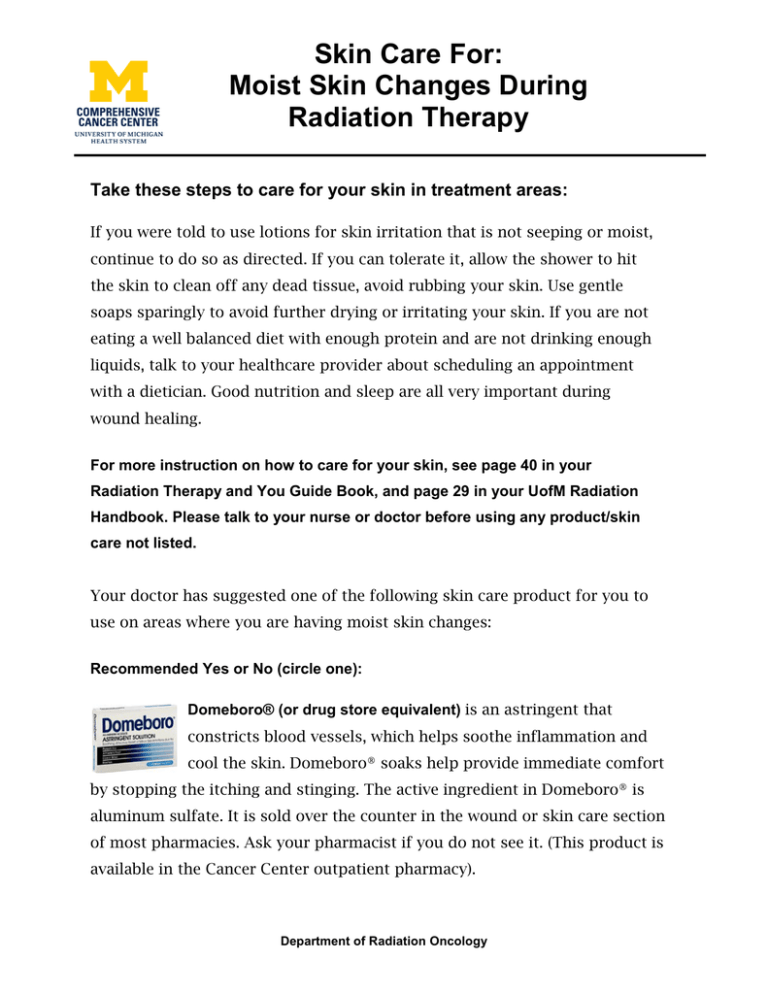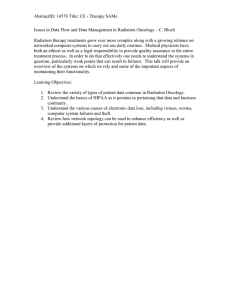Skin Care For: Moist Skin Changes During Radiation Therapy
advertisement

Skin Care For: Moist Skin Changes During Radiation Therapy Take these steps to care for your skin in treatment areas: If you were told to use lotions for skin irritation that is not seeping or moist, continue to do so as directed. If you can tolerate it, allow the shower to hit the skin to clean off any dead tissue, avoid rubbing your skin. Use gentle soaps sparingly to avoid further drying or irritating your skin. If you are not eating a well balanced diet with enough protein and are not drinking enough liquids, talk to your healthcare provider about scheduling an appointment with a dietician. Good nutrition and sleep are all very important during wound healing. For more instruction on how to care for your skin, see page 40 in your Radiation Therapy and You Guide Book, and page 29 in your UofM Radiation Handbook. Please talk to your nurse or doctor before using any product/skin care not listed. Your doctor has suggested one of the following skin care product for you to use on areas where you are having moist skin changes: Recommended Yes or No (circle one): Domeboro® (or drug store equivalent) is an astringent that constricts blood vessels, which helps soothe inflammation and cool the skin. Domeboro® soaks help provide immediate comfort by stopping the itching and stinging. The active ingredient in Domeboro® is aluminum sulfate. It is sold over the counter in the wound or skin care section of most pharmacies. Ask your pharmacist if you do not see it. (This product is available in the Cancer Center outpatient pharmacy). Department of Radiation Oncology Directions: • Mix one packet a day in 16 ounces of lukewarm or cool water. You will need to make a new solution every day; however you can divide the solution so that you have two or three separate solutions. • Saturate a clean gauze or washcloth in the solution and apply it to affected area for 20 minutes, 2-3 times a day. • Discard the solution after every use. Allow skin to air dry and then apply skin products as directed. Prescribed Yes or No (circle one): Silvadene® (Silver Sulfadiazine) treats skin infections in patients with severe burns. Do not use this medicine if you have ever had an allergic reaction to silver sulfadiazine. If you are allergic to sulfa drugs, check with your doctor before using silver sulfadiazine. This medicine is for use on the skin only. Do not put in or around the eyes. Directions: • Wash your hands before and after using the cream, the silver can stain your hands and clothes. • Clean off any dead skin or scabbing from the burn wound. You can do this in the shower (see instructions above) or with a soft clean cloth. • Spread a very thin layer of the cream over the wound, the areas that are moist and seeping or are suspicious for infection. • Cover the wound with a bandage (see below). • Keep the wound area clean at all times. Department of Radiation Oncology 2 • If you are still getting treatment, remove this ointment from your skin before your radiation treatments. Prolonged use of this ointment can delay wound healing. Follow these instructions for applying a bandage or dressing: Non-stick, or non-adherent dressings- Apply to moist open areas to absorb drainage. Avoid placing tape on irritated skin. Dressing can be purchased in a drug store or from medical supply companies with a prescription if your insurance will cover them. Other: Who should I call if I have questions? On weekdays, Monday thru Friday, 8:00 am to 5:00 pm, contact the Radiation Oncology Department at (734) 936-4300. On weekends, holidays or after 5:00 pm on weekdays, contact the paging operator at (734) 936-6267. Ask to have the On-Call Radiation Oncology Resident paged. Department of Radiation Oncology 3 Disclaimer: This document contains information and/or instructional materials developed by the University of Michigan Health System (UMHS) for the typical patient with your condition. It may include links to online content that was not created by UMHS and for which UMHS does not assume responsibility. It does not replace medical advice from your health care provider because your experience may differ from that of the typical patient. Talk to your health care provider if you have any questions about this document, your condition or your treatment plan. Author: Judy Baker, RN, BSN, OCN Reviewers: James Hayman, MD, MBA Patient Education by University of Michigan Health System is licensed under a Creative Commons Attribution-NonCommercial-ShareAlike 3.0 Unported License. Document: 01563. Last Revised: 10/2014 Department of Radiation Oncology 4
